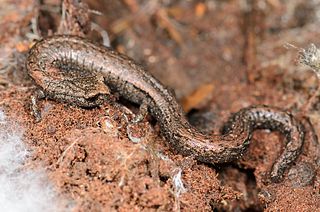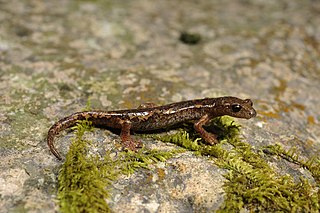
The Cryptobranchidae are a family of fully aquatic salamanders commonly known as the giant salamanders. They include the largest living amphibians. The family is native to China, Japan, and the eastern United States. They constitute one of two living families—the other being the Asiatic salamanders belonging to the family Hynobiidae—within the Cryptobranchoidea, one of two main divisions of living salamanders.

The Asiatic salamanders are primitive salamanders found all over Asia, and in European Russia. They are closely related to the giant salamanders, with which they form the suborder Cryptobranchoidea. About half of hynobiids currently described are endemic to Japan.

The Jefferson salamander is a mole salamander native to the northeastern United States, southern and central Ontario, and southwestern Quebec. It was named after Jefferson College in Pennsylvania.

The blue-spotted salamander is a mole salamander native to the Great Lakes states and northeastern United States, and parts of Ontario and Quebec in Canada. Their range is known to extend to James Bay to the north, and southeastern Manitoba to the west.

The four-toed salamander is a lungless salamander native to eastern North America. It is the only species of the monotypic genus Hemidactylium.

The small-mouth salamander is a species of mole salamander found in the central United States, from the Great Lakes region in Michigan to Nebraska, south to Texas, and east to Tennessee, with a population in Canada, in Pelee, Ontario. It is sometimes referred to as the Texas salamander, porphyry salamander, or the narrow-mouthed salamander. The Kelley's Island salamander was synonymized with A. texanum in 1995.

The Oita salamander is a species of salamander in the family Hynobiidae endemic to Japan. Named after Ōita Prefecture, its natural habitats are temperate forests, rivers, intermittent rivers, freshwater marshes, intermittent freshwater marshes, and irrigated land in western Japan. It is threatened by habitat loss, due to the increasing construction of homes within its habitat. The Oita salamander is considered to be vulnerable by the (IUCN) Red List of Threatened Species with a declining population.
The amber salamander, amber-colored salamander, tortoiseshell salamander, or Stejneger's oriental salamander is a species of salamander in the family Hynobiidae, endemic to Japan. Its natural habitats are temperate forests and rivers. It is threatened by habitat loss.

Pachyhynobius shangchengensis, the Shangcheng stout salamander, is a species of salamander in the family Hynobiidae. It is monotypic within the genus Pachyhynobius. It is named after its type locality, Shangcheng. It is endemic to the Dabie Mountains in central China. Its natural habitats are subtropical moist lowland forests, montane forests, and rivers. It is threatened by habitat loss.
Liua tsinpaensis, the Tsinpa salamander, is a species of salamander in the family Hynobiidae. It is synonymous with Ranodon tsinpaensis and is endemic to China. It occurs in southern Shaanxi and in Wanyuan, northeastern Sichuan. Its natural habitats are subtropical or tropical moist montane forests and rivers. It is threatened by habitat loss.

Leptobrachium boringii, commonly known as the Emei moustache toad or Taosze spiny toad, is a species of amphibian in the family Megophryidae. It is endemic to China where it is found in Sichuan, Guizhou, and Hunan provinces. "Emei" or "Taosze" in its common names refer to its type locality, Taosze on Mount Emei, Sichuan. Its natural habitats are temperate forests, grassland, arable land, and rural gardens near rivers. It is threatened by habitat loss.

The gregarious slender salamander is a species of salamander in the family Plethodontidae. Its natural habitats are California interior chaparral and woodlands and temperate grasslands in the lower foothills of the western Sierra Nevada and the eastern Central Valley in California, United States.
The northern banana salamander, also known as common dwarf salamander or rufescent salamander, is a species of salamander in the family Plethodontidae. It is found in the Atlantic slopes of Meso-America from San Luis Potosi, Veracruz, and northern Chiapas in Mexico continuing on to the southern part of Guatemala, Belize, and northern Honduras. However, its range south of Mexico is uncertain because the records may refer to other species.

The seepage salamander is a small, terrestrial species of salamander in the family Plethodontidae. It is endemic to the United States. They are found in small areas of Tennessee, North Carolina, Georgia, and Alabama. Its natural habitats are temperate forests, intermittent rivers, and freshwater springs. It gets its name from the seepages around which it lives. It is very similar in its appearance and life history to the pygmy salamander. These two species differ greatly from the other Desmognathus species. They are the smallest salamanders in the genus, measuring only 3–5 cm (1–2 in) in length. They are also the only two terrestrial, direct-developing Desmognathus species. However, the two species are not often seen to coexist, differing in distribution by elevation; although there are exceptions. The seepage salamander is currently listed as Near Threatened, with its numbers declining in most of states in which it is found. It is threatened by habitat loss, with logging having a major effect.

The ocoee salamander is a species of salamander in the family Plethodontidae. This salamander has a variety of colors and patterns, and got its name from Tennessee state wildflower. Its natural habitats are temperate forests, rivers, intermittent rivers, freshwater springs and wet rocks in mountainous areas of the Southeastern United States. It was first described by Nicholls in 1949. They are territorial and feed on small invertebrates. It is widely distributed in the southeastern United States and is listed as "Least Concern" by the International Union for Conservation of Nature.

The pygmy salamander is a species of salamander in the family Plethodontidae. It is endemic to the United States in the southern Appalachians in North Carolina and Tennessee. Desmognathus wrighti is a member of the family Plethodontidae and is commonly known as the pygmy salamander. As the name suggest the pygmy salamander is the smallest of the nineteen species in the genus Desmognathus. D. wrighti undergoes direct development and does not have a free-living larval stage. Only two other taxa in Desmognathus, D. aeneus and D. organi, exhibit direct development along with the pygmy salamander. In the genus Desmognathus, body size, habitat preferences, and patterns used by males during courtship are quite variable. D. wrighti courtship is noted by the male biting and seizing its partner in order to provide them with a chemical stimulus. The pygmy salamander can be found in the southern Appalachians of the United States in western North Carolina and eastern Tennessee. Geographical distribution of the Desmognathus wrighti is fragmented and the highest abundance of the species can be found at high elevations in spruce and fir tree forest.

The spring salamander is a species of salamander in the family Plethodontidae. It is found in Canada and the United States. The genus, Gyrinophilus, means "tadpole lover" and refers to the long period of time it spends as a gilled larva before maturing. The specific epithet, porphyriticus, is Latin from Greek, meaning the color of porphyry, a purple stone, and this salamander has also been called the purple salamander.

Ambrosi's cave salamander or the Spezia cave salamander is a species of salamander in the family Plethodontidae. Endemic to northwestern Italy, its natural habitats are temperate forests, rocky areas, caves, and subterranean habitats. It is threatened by habitat loss.

The Italian cave salamander is a species of salamander in the family Plethodontidae. Endemic to Italy, its natural habitats are temperate forests, rocky areas, caves, and subterranean habitats. It is threatened by habitat loss.

The green salamander is a species of lungless salamander in the family Plethodontidae. It and the Hickory Nut Gorge green salamander are the only currently-described members of the genus Aneides that inhabit any areas in the eastern half of United States. Rarely seen in the field, the green salamander is an extremely habitat-specific species that is seldom found away from its preferred surroundings: moist, shaded rock crevices.


















